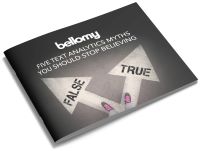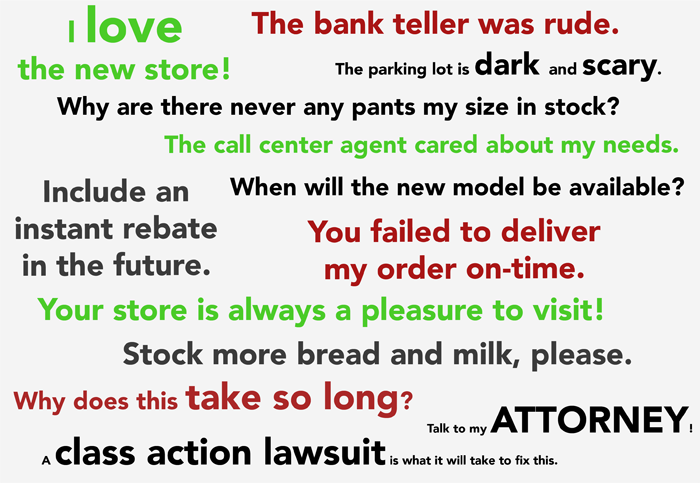Using text analytics to find what you're missing in consumer comments
What are you missing in consumer comments?
Do you extract the maximum value from the treasure trove of consumer comments you have? Do the survey responses, social media posts, store reviews, service emails, and chats add up to meaningful business improvements?
Text analytics extracts the value hidden in consumers' words
The volumes of consumer comments now available to organizations must be mined effectively to identify and extract the value hidden in the words of consumers. No single approach is right for every need, and no fully automated system can ever replace the need for a human analyst when examining unstructured data. We believe that the best method for maximizing the value of text is by empowering humans with tools that enable effective mining and building frameworks and constructs that continuously build upon past successes. Each successive generation of tools puts more context and organization into the hands of talented analysts, but without their unique perspectives and deep understanding of human behavior and client industries and needs, the potential from text mining is never achieved.
 Unstructured data is complex and so are the tools used to analyze it. Make sure you’re not falling for one of these five common text analytics misconceptions — but here's what to do about it if you are.
Unstructured data is complex and so are the tools used to analyze it. Make sure you’re not falling for one of these five common text analytics misconceptions — but here's what to do about it if you are.
Leveraging unstructured data and the basic need to express oneself
 From years of interacting with research respondents and listening to consumers on social media, we have come to realize that there are common themes that run through all forms of human communication. There are basic human needs that are expressed through words. Enabling organizations and analysts to see these themes is critical to efficiently leverage text and unstructured data for business insights. Properly analyzing these expressions allows organizations to frame a response, identify product and brand opportunities, train and enable their staff, and much more.
From years of interacting with research respondents and listening to consumers on social media, we have come to realize that there are common themes that run through all forms of human communication. There are basic human needs that are expressed through words. Enabling organizations and analysts to see these themes is critical to efficiently leverage text and unstructured data for business insights. Properly analyzing these expressions allows organizations to frame a response, identify product and brand opportunities, train and enable their staff, and much more.
So how can we organize these themes to enable customers and analysts to more easily find meaning? And as a company, how do we provide this service without needing to re-invent tools for each new client, project, question, or source of consumer comments?
This is where Bellomy's proprietary "content actionability model" comes in.
Content actionability model
This standard, reusable model analyzes a body of text and classifies each consumer comment as one or more of these common themes:
- Praise
- Complaint
- Suggestion
- Question
- Safety/privacy concern
- Legal concern
- Information
The recurring themes we find in consumer comments are often paired with emotional expressions as well. These emotional expressions can help organizations identify strengths and weaknesses and differentiate their population of consumers based on underlying human needs and concerns.
Emotion model

- Anger
- Anticipation
- Disgust
- Fear
- Joy
- Surprise
- Sadness
- Trust
This model further enables users to have a sense of how the body of consumers is feeling about a product, service, offering, or situation. These emotional expressions can be useful in identifying groups of a population that are struggling with a brand or product, and may also reveal real insights that can power product innovation and design by addressing core human emotional needs. Our proprietary "emotion wheel" helps users quickly grasp the emotions being expressed within the text. Each slice of the wheel shows the relative quantity of comments that express each emotion. The color ranges from green to red with intense green representing positive sentiment and intense red representing negative sentiment.
Aligning consumer feedback with business needs
Developing or improving products
- Suggestion and Question categories often lead directly to product and brand innovation and ideas.
Coaching employees to improve customer experience, sales, and more
- Praise and Complaint categories reveal both areas of strength and weakness within an organization and for specific agents/employees.
Assessing marketing or advertising effectiveness
- Question categories often reveal gaps in the consumer comprehension of marketing and media.
Reducing risks
- The Safety & Privacy category, as well as the Legal category, are key to identifying risks that may need to be addressed quickly.
Retaining customers
- Complaints are often warning signs that customer loyalty is in jeopardy.
Segmenting customers into differentiated groups for targeting efforts
- The emotion model is perfectly matched to this fundamental business need. The emotions that customers express in text are often tied to larger and more ingrained emotional attachments they have formed with a brand, product, location, etc. Some are short-lived and can be changed (from fear to joy when major safety issues are fixed quickly), while others simply tie to the way consumers relate to a brand.
Using emotion to improve segmentation models and fine-tune approaches to consumer engagement can lead to considerable gains in business outcomes.
How can we help you better leverage your consumer's voice?
Bellomy's team of marketing insight professionals is equipped to help your business identify and then leverage the consumer expressions found in the consumer's shared voices. Reach out today to learn how our technology can drive improvements to your customer experience.
- text analytics

